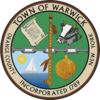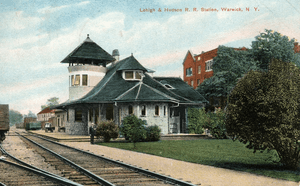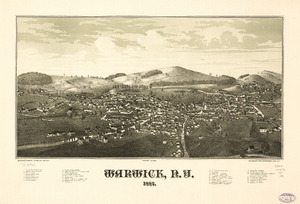Warwick, New York facts for kids
Quick facts for kids
Warwick, New York
|
|||
|---|---|---|---|
| Town of Warwick | |||
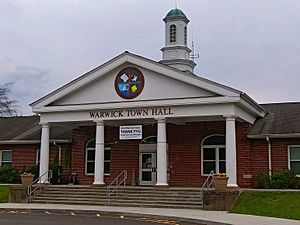
Warwick Town Hall
|
|||
|
|||
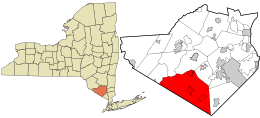
Location in Orange County and the state of New York
|
|||
| Country | |||
| State | |||
| County | Orange | ||
| Incorporated | 1789 | ||
| Area | |||
| • Total | 104.87 sq mi (271.61 km2) | ||
| • Land | 101.29 sq mi (262.33 km2) | ||
| • Water | 3.58 sq mi (9.28 km2) | ||
| Elevation | 538 ft (164 m) | ||
| Population
(2020)
|
|||
| • Total | 32,027 | ||
| • Density | 305.397/sq mi (117.915/km2) | ||
| Time zone | UTC−5 (EST) | ||
| • Summer (DST) | UTC−4 (EDT) | ||
| ZIP Code |
10990
|
||
| Area code(s) | 845 | ||
| FIPS code | 36-78366 | ||
| GNIS feature ID | 0979600 | ||
| Website | www.townofwarwick.org | ||
Warwick is a lovely town in the southwestern part of Orange County, New York. It's home to over 32,000 people, according to the 2020 census. This town includes three villages: Florida, Greenwood Lake, and Warwick. It also has eight smaller communities called hamlets.
Contents
- Exploring Warwick's Past: A Look at Its History
- Warwick's Location and Natural Beauty
- Who Lives in Warwick? Population Facts
- Learning in Warwick: Schools and Education
- Fun in Warwick: Festivals and Events
- Getting Around Warwick: Transportation
- Warwick's Communities and Places to See
- Famous People from Warwick
- See also
Exploring Warwick's Past: A Look at Its History
In the early 1700s, a man named Benjamin Aske owned land here. He named it "Warwick," possibly after a place in England. He started selling parts of his land to new settlers in 1719. Lawrence Decker bought the first 100 acres. More families moved to the valley between 1730 and 1765.
During this time, the number of Native American people living there decreased. Forests were cleared for farms and homes. By the time the American Revolution began, most native people had left. The area was called Warwick for a long time. It officially became a town in 1788.
Warwick's Role in the American Revolution
Warwick played a part in the American War for Independence. The Continental Army had a camp here. The famous Hudson River Chain was made in Warwick. This huge chain helped stop British ships from sailing up the Hudson River. In 1783, George Washington visited Warwick. He stopped at Baird's Tavern and stayed at John Hathorn's house.
Warwick grew because of its freight rail line. This was common for many towns in Orange County. A writer named Henry William Herbert made the area famous. He wrote a book called "The Warwick Woodlands" in 1845. Today, Warwick is a rural town. Farming is a big part of its economy.
Warwick's Location and Natural Beauty
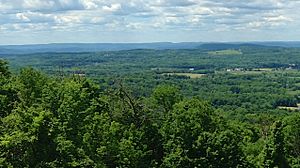
The town of Warwick is in the southern part of Orange County, New York. It shares borders with towns in New Jersey, like Vernon and West Milford. To the north, it borders Chester. To the east, it borders Tuxedo, home of the New York Renaissance Faire.
Warwick is the second largest town in New York State. It covers about 104.9 square miles (271.6 km2). Most of this is land, but about 3.2 square miles (8.3 km2) is water. Greenwood Lake is the biggest lake in Orange County. It is split between New York and New Jersey. Glenmere Lake is also partly in Warwick. It is an important home for endangered animals.
Warwick has its own Warwick Municipal Airport. Two state highways, New York State Route 17A and NY 94, pass through it. The famous Appalachian Trail also goes through Warwick. The town is known as an Appalachian Trail Community.
What's the Weather Like in Warwick?
| Month | Jan | Feb | Mar | Apr | May | Jun | Jul | Aug | Sep | Oct | Nov | Dec | Year |
|---|---|---|---|---|---|---|---|---|---|---|---|---|---|
| Mean daily maximum °F (°C) | 35 (2) |
38 (3) |
47 (8) |
61 (16) |
70 (21) |
78 (26) |
83 (28) |
81 (27) |
75 (24) |
63 (17) |
51 (11) |
40 (4) |
60 (16) |
| Mean daily minimum °F (°C) | 17 (−8) |
18 (−8) |
26 (−3) |
37 (3) |
47 (8) |
55 (13) |
60 (16) |
59 (15) |
51 (11) |
40 (4) |
31 (−1) |
23 (−5) |
39 (4) |
| Average precipitation inches (mm) | 3.1 (79) |
2.6 (66) |
3.6 (91) |
4.0 (100) |
4.0 (100) |
4.4 (110) |
3.8 (97) |
4.3 (110) |
4.2 (110) |
3.7 (94) |
3.6 (91) |
3.4 (86) |
44.7 (1,134) |
| Average snowfall inches (cm) | 12.2 (31) |
9.4 (24) |
6.7 (17) |
1.2 (3.0) |
0.0 (0.0) |
0.0 (0.0) |
0.0 (0.0) |
0.0 (0.0) |
0.0 (0.0) |
0.0 (0.0) |
1.6 (4.1) |
7.8 (20) |
38.9 (99.1) |
| Average precipitation days (≥ 0.01 in) | 7 | 6 | 8 | 8 | 9 | 9 | 7 | 8 | 7 | 6 | 7 | 7 | 89 |
| Mean daily daylight hours | 9.5 | 10.5 | 12.0 | 13.0 | 14.5 | 15.0 | 15.0 | 14.0 | 12.5 | 11.0 | 10.0 | 9.5 | 12.2 |
| Source: NOAA/Google | |||||||||||||
Who Lives in Warwick? Population Facts
| Historical population | |||
|---|---|---|---|
| Census | Pop. | %± | |
| 1820 | 4,506 | — | |
| 1830 | 5,013 | 11.3% | |
| 1840 | 5,113 | 2.0% | |
| 1850 | 4,902 | −4.1% | |
| 1860 | 4,628 | −5.6% | |
| 1870 | 5,736 | 23.9% | |
| 1880 | 5,699 | −0.6% | |
| 1890 | 6,000 | 5.3% | |
| 1900 | 6,403 | 6.7% | |
| 1910 | 7,141 | 11.5% | |
| 1920 | 7,462 | 4.5% | |
| 1930 | 8,017 | 7.4% | |
| 1940 | 9,369 | 16.9% | |
| 1950 | 9,828 | 4.9% | |
| 1960 | 12,551 | 27.7% | |
| 1970 | 16,956 | 35.1% | |
| 1980 | 20,976 | 23.7% | |
| 1990 | 27,193 | 29.6% | |
| 2000 | 30,764 | 13.1% | |
| 2010 | 32,065 | 4.2% | |
| 2020 | 32,027 | −0.1% | |
| U.S. Decennial Census | |||
In 2000, about 30,764 people lived in Warwick. There were 10,868 households. Most people were White (91.06%). About 4.51% were Black or African American. About 6.47% of the population was Hispanic or Latino.
Many households (38.5%) had children under 18. Most families (61.7%) were married couples. The average household had 2.74 people. The average family had 3.25 people.
The population was spread out by age. About 27.2% were under 18. About 31.3% were between 25 and 44 years old. The average age was 38 years.
Learning in Warwick: Schools and Education
The Warwick Valley Central School District serves most students in Warwick. It also serves some students from the southern part of Chester. The Greenwood Lake Union Free School District serves Greenwood Lake. Students there go to GWL Elementary and Middle Schools. For high school, they can choose between Chester Academy or Warwick Valley High School. The Florida NY Union Free School District serves Florida, NY. Students attend Golden Hill Elementary School and S.S. Seward Institute.
Fun in Warwick: Festivals and Events
Warwick's Famous Applefest
Applefest is a very popular festival. It happens every October. As many as 35,000 people come to enjoy it. It's a big outdoor event for the community.
Music and History: Other Local Events
The Hudson Valley Jazz Festival takes place in the summer. It was first called the Warwick Valley Jazz Festival.
The annual George Washington Day 5K is a special tradition. It celebrates when George Washington visited Warwick. He enjoyed a drink with his men at Baird's Tavern. This fun event happens in July. The Warwick Historical Society helps keep this tradition alive.
Getting Around Warwick: Transportation
Warwick has bus services to Manhattan. These are the 196 and 197 buses. They are run by New Jersey Transit. There is also a local bus service within Warwick.
Warwick's Communities and Places to See
Warwick is made up of several villages and hamlets. Each has its own unique character.
- Warwick – This is a village where NY 94 and NY 17A meet.
- Florida – A village located on NY 17A.
- Greenwood Lake – A village on NY 17A at the north end of Greenwood Lake.
- Amity – A hamlet near the New Jersey border. It has a historic church from 1796.
- Bellvale – A hamlet on NY 17A between Warwick village and Greenwood Lake.
- Edenville – A hamlet in the western part of Warwick.
- Pine Island – A hamlet known as the center of the "black dirt" farming region.
- Sterling Forest – A hamlet near the New Jersey border. It was once home to Babe Ruth. The Jehovah's Witnesses' world headquarters is also here.
- Glenmere Lake – A lake that is home to the endangered northern cricket frog.
- Greenwood Lake – A large lake shared with New Jersey.
- Mount Adam and Mount Eve – Two mountains near the "black dirt" region.
- Sterling Lake – A lake in the eastern part of the town.
- Wallkill River National Wildlife Refuge – Part of this wildlife area is in Warwick.
- Wickham Lake – A small lake near the northern town line.
Famous People from Warwick
Many interesting people have connections to Warwick:
- Damon Amendolara – A radio host.
- James Cromwell – An actor and environmental activist.
- Jasper Francis Cropsey – A famous artist from the Hudson River School.
- Derek Jeter – A famous baseball player who owns a home on Greenwood Lake.
- Richard Kiley – A well-known actor.
- William H. Seward – He was Abraham Lincoln's Secretary of State. He was born in Florida, a village in Warwick.
- Jimmy Sturr – A Grammy Award-winning musician.
See also
 In Spanish: Warwick (Nueva York) para niños
In Spanish: Warwick (Nueva York) para niños



